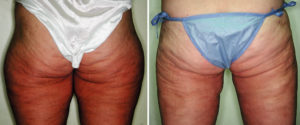The shape of the thighs has long been an aesthetic interest/concern for some women. The most common thigh deformity are saddle bags, those outward protrusions that violate a straight or gently convex curve from the hip down to the knee. But the inner thigh is also an area of thigh insecurity as well with bulges and sagging skin that obscures a smooth line upward into the genital area.
An often requested inner thigh goal is to have a space created between the inner thighs. Sometimes this is to get rid of rubbing or a chronic irritation from continuous tissue contact. Others seek a more ambitious aesthetic goal where one can see right through the inner thighs like a model going down the runway. Recent reports act as if this is a new cosmetic request (the thigh gap trend) but the reality is that it has been a long-standing concern for as long as plastic surgeons can remember.

The reality of inner thigh surgical and non-surgical treatments is that they can be effective but rarely, if ever, can create an open inner thigh space. Unless one is thin enough that they naturally have a gap or are predisposed to one, it is very difficult to create it. One should expect inner thigh shape improvements with various treatments but the creation of a gap is not realistic for most patients.
Dr. Barry Eppley
Indianapolis, Indiana


